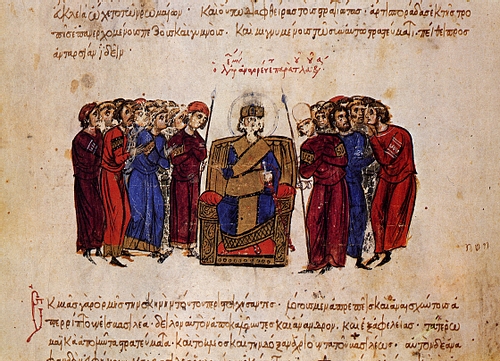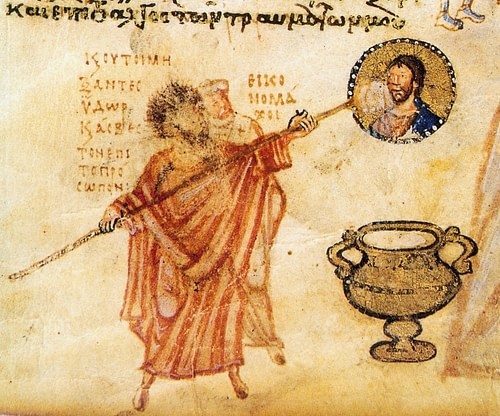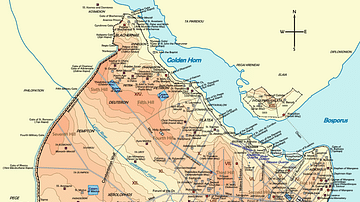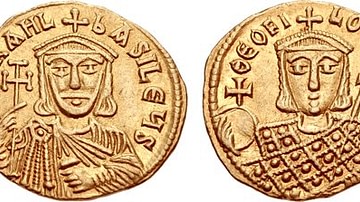
Leo the V the Armenian was emperor of the Byzantine Empire from 813 to 820 CE. He was of Armenian descent and the last ruler of the Isaurian dynasty which had been founded by Leo III (r. 717-741 CE). The emperor's reign, after early military successes against the Bulgars, is chiefly remembered for beginning the second wave of iconoclasm in the Byzantine Church, that is the destruction of religious icons and treating those who worshipped them as heretics.
Succession
Emperor Michael I Rangabe (r. 811-813 CE), was a big spender on churches and monasteries but in warfare he proved hopeless. Defeats to Krum, the Khan or leader of the Bulgars (r. 803-814 CE), and a mutiny within his own army meant that Michael's days were numbered. The general Leo was selected as a figure more suitable to defend the empire in these troubled times. Leo, an Armenian of humble origins, had risen in the Byzantine army by sheer talent to eventually become the strategos or military governor of the province (theme) of Anatolikon, the most important region of Asia Minor and a vital bulwark against the invading Arabs. Leo pushed events to a crisis in June 813 CE at the battle of Versinicia near Adrianople. Facing a Bulgar army, Leo and his Anatolian troops withdrew from the field, leaving the remaining Macedonian troops to be slaughtered. The Bulgar army then marched to Constantinople and camped by the Theodosian Walls of the city.
Michael abdicated and fled to seek refuge in a church; he avoided the awful fate of most Byzantine emperors who lost their throne to a usurper, but his male children were castrated and his wife and daughters sent to a convent to make sure none ever tried to reassert their claim to the throne. Michael himself was banished to a monastery on an island in the Marmara and Leo was proclaimed Emperor Leo V.
Krum & the Bulgars
The new emperor's immediate task was to deal with the capital's new neighbours in the Bulgar army camp, but neither side ever doubted the impregnability of the Theodosian Walls. Instead, then, of a futile siege, Krum demanded a huge ransom in gold with a bonus batch of the most beautiful women the Byzantines could round up. Leo offered to meet Krum in person, unarmed and accompanied only by a handful of retainers, where the city's fortifications ran down into the sea. It was a trick, of course, and three of the emperor's henchman tried to kill the Bulgar leader. Krum managed to escape on his horse but was wounded, nevertheless. He became, understandably, intent on exacting some sort of terrible revenge. The next day the Bulgars torched the extensive settlements, monasteries and churches which lay beyond the protection of the capital's walls. Any individuals still in the area were killed without mercy, and the Bulgar army withdrew leaving a trail of destruction as they marched back home. Entire towns and villages were wiped out, notably the city of Adrianople whose 10,000 inhabitants were taken prisoner and marched across the Danube.

Leo responded with a surprise attack on a Bulgar army camped near Mesembria on the Black Sea coast of Bulgaria. Leading, as always, his army in person, the emperor crushed the enemy and, advancing deeper into Bulgar territory, ruthlessly butchered the civilian populations he came across, including women and children. Outraged, Krum decided to attack Constantinople after all in the early spring of 814 CE, regardless of the city's formidable defences. Fully aware of the task ahead, the Bulgar Khan made meticulous preparations and amassed the necessary siege engines, catapults, and battering rams. It was all to no avail, though, as Krum died unexpectedly of a seizure (probably a stroke), and his successor, his young son Omortag, had enough on his plate dealing with a rebellion of his own aristocracy at home and the Franks threatening his western frontier to worry about the near-impossible task of taking Constantinople. The Bulgar army returned home, and a peace treaty was signed which re-established the borders of 780 CE. Gradually, the ravaged cities in Thrace and Macedonia were rebuilt by Leo, who proved something of an able administrator besides a gifted general. With the empire's other major enemy of the period, the Arab Caliphate, similarly incapacitated by internal strife, Leo was finally able to turn his attention to his own domestic affairs.
Iconoclasm
For many Byzantine rulers, the biggest ideological challenge to their rule and number one enemy was those in the Christian church who supported the veneration of icons. Leo was to be no different, even if most of the discord was of his own doing. In 815 CE, following a council of Church elders convened by the learned Armenian monk John (VII) Grammatikos in Constantinople, Leo began a second wave of iconoclasm in the Byzantine Church (the first having occurred between 726 and 787 CE), whereby all prominent religious icons were destroyed and those who venerated them were persecuted as heretics.
The motivation for the emperor to support iconoclasm, as it had been for his predecessors like Constantine V (r. 741-775 CE), besides being an obvious way to exert imperial authority over the Church in general, was the belief that a string of military defeats was God's punishment for venerating idols. The belief was strengthened when certain victories came during the first wave of iconoclasm and during this second wave, too, there were modest victories for Byzantine armies against the Bulgars. Leo himself may not have held such convictions, but enough members of the army and peasantry did to make the issue a possible source of unrest if the emperor did not make some sort of move against the iconophiles.
Initial opposition to the new policy was led by the Patriarch (Bishop) of Constantinople, Nikephoros I, who refused to sign the formal decree of iconoclasm issued by the council. Nikephoros was promptly replaced by the more sympathetic Theodotos I Kassiteras. Amongst the most prominent victims of the second persecution were the monks Theodore Graptos, who had his forehead branded for his beliefs, and Theophanes the Confessor, author of the Chronographia, a celebrated history of Byzantium from the 3rd to 9th century CE. The reign of terror against iconophiles would not end until 843 CE, the movement to rid the Church of icons ultimately losing imperial backing and being unable to convince the majority of Christians who continued to venerate icons privately anyway.
Death & Successors
Leo had always rewarded his supporters in the army so that ambitious men like Thomas the Slav, Manuel and Michael the Amorian were promoted to the top military positions of the empire. However, this policy backfired somewhat when Michael, Leo's oldest and closest ally, had the emperor murdered in the chapel of the Great Palace of Constantinople on Christmas Day in 820 CE. Actually, Michael was rather pushed into his dramatic action as he had just been condemned to death by Leo the day before - the novel method decided upon involved tying the victim to an ape and putting the pair into the furnaces which heated the palace baths. Michael, accused of plotting a rebellion, was saved from this ignominious end by his supporters who disguised themselves as a choir of monks and butchered the emperor. Leo proved not such an easy target, though, and he defended himself with a large metal cross for an hour before finally succumbing to the assassins.
Michael II was released from his prison and immediately crowned, still wearing his chains as no one could find the keys. Meanwhile, Leo's mutilated body was dragged naked around the Hippodrome of Constantinople for public ridicule. Michael, having gained the throne for no other reason than personal ambition, would found the Amorion dynasty and reign until 829 CE when he was succeeded by his son Theophilos (r. 829-842 CE) who vehemently continued the persecution of iconophiles.
This article was made possible with generous support from the National Association for Armenian Studies and Research and the Knights of Vartan Fund for Armenian Studies.







